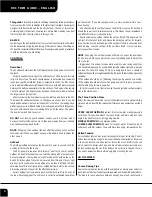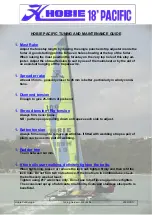
Shifting to neutral will slow progress, but allowance must be made
for continue movement. See information following for suggestions
regarding docking.
The power button is a safety measure. It allows the operator an op-
portunity to briefly and visually check the electrical system opera-
tion prior to starting. The key also reduces the likelihood of theft of
the boat or unauthorized use. Always remove and take the key with
you when the outing is done.
130—Get Ready
To Turn OFF—Response TXi
On an ignition-only boat, turn the key to OFF. On a boat equipped
with a START/STOP button, press the button. If the outing is done,
also turn the key to OFF. Click the power button to turn the system off
on boats equipped with the power button. (Failing to do so allows the
electrical system to continue to function; eventually, this will drain
the battery or batteries.)
Note that, unlike a dry-land vehicle, turning OFF the boat does
not immediately stop its momentum. The boat will continue to move.
monitor the readings. Pay particular attention to the oil pressure and
engine temperature information as these are the earliest warnings
when something is going wrong with the drive train. Alarms will
sound if serious problems are encountered.
Also, check carefully for leaks. The break-in period is the most
likely time for leaks to appear, whether fuel, oil, water, or exhaust.
BREAK-IN PERIOD—ALL BOATS
The first hours of the boat operation have critical requirements
for engine break-in. This information is contained in the
Engine sec-
tion in the manual, where appropriate. Be sure to review this in-
formation carefully. Failure to follow the instructions will void the
engine warranty!
With regard to the boat, pay close attention to the screens, and
important to achieve the kind of maneuverability that is desirable.
Remember that steering in a boat is from the rear (stern). The un-
seen rudder operates from the steering wheel, but the actual steer-
ing through the rudder is different from a car. Note that stern control
means that the boat will push away from the direction of the turn.
The bow will follow a smaller turning circle than the stern does.
Note that the propeller does not move the boat directly forward.
Due to the rotation (generally, counterclockwise), the boat’s natural
progress will have a slight tracking to the port side (when in for-
ward gear) and starboard side when in reverse. At slower speeds,
this phenomenon is more pronounced. Depending also on the body
of water depth and width, it may be necessary for the operator to
compensate for this natural movement.
SMART OPERATIONS
Newcomers to boating, especially boats the size of the Malibu
models, are strongly encouraged to take a U.S. Coast Guard boating
class before using the boat. Reading about boating conditions and
operations from websites such as the National Marine Manufactur-
ers Association (NMMA) and the many yachting association sites can
be very helpful.
Practice, practice, practice!
Begin in optimum weather and wa-
ter conditions, avoiding tight quarters until you are comfortable. The
boat actually steers more easily when the boat is on plane. This is
achieved by speeding up briskly from idle. By throttling and increasing
the speed, the boat will ride up higher on the body of water. With less
friction between boat hull and water, the boat will maneuver more
easily. At slower speeds, the boat is less responsive, so practice is
speed before attempting these shifts and do not shift into reverse if
the boat is moving faster than 2 mph (3.2 km/h).
Do not disconnect the emergency safety
switch as a method to stop the boat. Do-
ing so impairs the ability to restart the
engine quickly or it may create a hazardous swamping condition.
STOPPING
The lack of brakes requires the operator to think more quickly
and react accordingly to avoid damaging contact with other boats,
docks, and the shore. When stopping the boat, it is acceptable to
use reverse gear (much as airplanes use reverse thrust). This is a
technique that takes time and practice to master. Slamming from
forward to reverse gear can damage the system. Allow sufficient
time to move the shifter from forward to neutral, briefly pausing with
each shift, and then ease into reverse. Always slow to a no-wake
HIGH SPEED MANEUVERS
Competitions may showcase the driving skills of professional op-
erators. Tempting as it may be to try the same kind of extraordinary
maneuvers, the vast majority of operators should avoid boating at
top speed. Professionals are trained to plan and prepare in the event
something goes wrong.
The engines are built and tuned to run at the optimum speed range
for water skiing, wakeboarding, wake surfing, and similar activities.
Higher speeds are achievable, but the intent is only brief bursts of
speed in those instances where the Malibu operator needs to move
quickly to get out of a potentially dangerous situation.
Attempting to replicate the high-speed
maneuvers of professional boat drivers
can lead to loss of control, damage to
the boat, and serious injury or death to
the operator and passengers.
Weather conditions and altitude can affect the best operating
range for the engine. If you feel that you are not getting the expected
performance from your boat, contact your authorized Malibu dealer
to discuss changing or adjusting the propeller to compensate. Do not
attempt to do this without assistance as it may void the boat and/or
engine warranty.
















































